It’s not lying if we didn’t actually say it
By John Duffy (The Devil Makes Three)
A picture is worth a thousand words. Maybe more. And video, heck, that might be worth a million. If you have found your way to reading this piece, I have to imagine that you’re a bit more savvy than the average bear, so what follows probably won’t shock you, but I felt compelled to write about it none the less.
There is a commonly used maxim to explain media coverage that goes, “if it bleeds, it leads,” and for the last year and a half if you have engaged with the mainstream media at all, you have seen this slogan in action. Coronavirus death and case tickers running on the sidebars of cable news networks, breathless reports about variants in major publications, condemnations of public events that in just two more weeks will inevitably lead to mass death, etc.
After being inundated with bad news, a Dartmouth College professor decided to catalogue thousands of articles about COVID-19 and found that in the US, 90% of the coverage was negative. I personally was keeping a collection of what I found to be false reporting regarding COVID-19 in the event that I wanted to release a large chronicle of it at some point. One of my favorite current examples is how The Atlantic ran a piece in the winter of 2020 that quoted an “expert” who claimed emphatically that the healthcare system in Iowa was about to collapse. The article was called, The U.S. Has Passed the Hospital Breaking Point. In the December 4th article, the authors Robinson Meyer and Alexis C Madrigal wrote:
“The pandemic nightmare scenario—the buckling of hospital and health-care systems nationwide—has arrived. Several lines of evidence are now sending us the same message: Hospitals are becoming overwhelmed, causing them to restrict whom they admit and leading more Americans to die needlessly.”
They go on to say:
“‘The health-care system in Iowa is going to collapse, no question,” an infectious-disease doctor told our colleague Ed Yong early last month. The following week, a critical-care doctor in Nebraska warned, “The assumption we will always have a hospital bed for [you] is a false one.”
These catastrophes seem to be coming to pass—not just in Iowa and Nebraska, but all across the country. A national breakdown in hospital care is now starkly apparent in the coronavirus data.”
That infectious disease doctor was Eli Perencevich, of the University of Iowa. And boy was he wrong. Yes, at that time cases were on the rise and deaths followed, but as was the case basically everywhere, there was a rise and fall that were roughly symmetrical, that never went exponential to the moon, and that never caused one hospital to fall into smoking ruins.
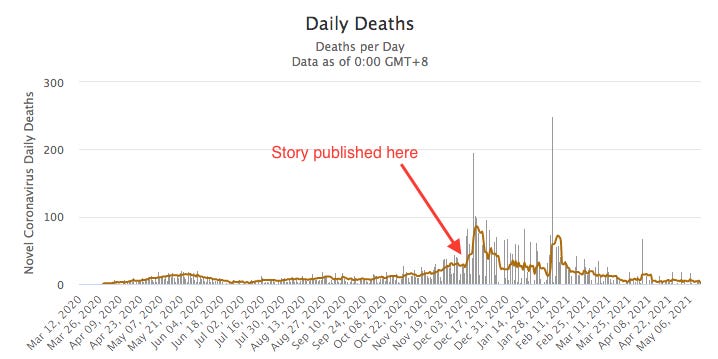
Now, for the journalists at the Atlantic to quote him, isn’t exactly the same thing as the journalists themselves claiming that the Iowa hospitals were about to collapse, so they can always moonwalk their way off stage left when the prediction doesn’t come to pass. But they did claim that “A national breakdown in hospital care is now starkly apparent in the coronavirus data.” I guess they could defend themselves over what the definition of “breakdown,” means, butwhat makes the whole thing so funny to me, is how later, The Atlantic released an article called The Liberals Who Can’t Quit Lockdown inwhich the author writes:
“The spring of 2021 is different from the spring of 2020, though. Scientists know a lot more about how COVID-19 spreads—and how it doesn’t. Public-health advice is shifting. But some progressives have not updated their behavior based on the new information.”
Let’s ignore for a moment that by the summer and fall of 2020, a lot was known about SARS-COV-2 that these same liberals were ignoring, and just chuckle at how The Atlantic is bemoaning their own Frankenstein’s monster that they helped to birth. Three months after telling us there won’t be hospital beds, that a national breakdown is underway, they scratch their heads and wonder why everyone is still so freaked out.
But when it comes to bad media and COVID-19, what I find even more fascinating is the use of photography to tell the story, and just how damned disingenuous it has been since the get go, all in the service of creating a narrative in the mind’s of the public of a Hollywood level pandemic that could snatch life from anyone, anytime, and how this use of images convinced so many people to think that if we had open restaurants, gyms, or malls, we would have to use snowplows to pile up the corpses outside of Red Lobsters and Planet Fitnesses across the land.
It started in Wuhan last January with images like this:
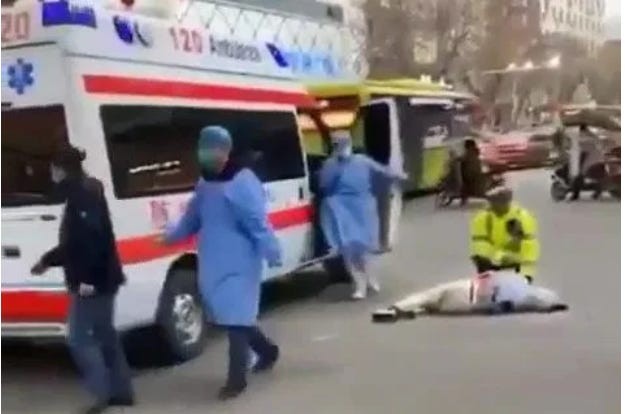
And this:
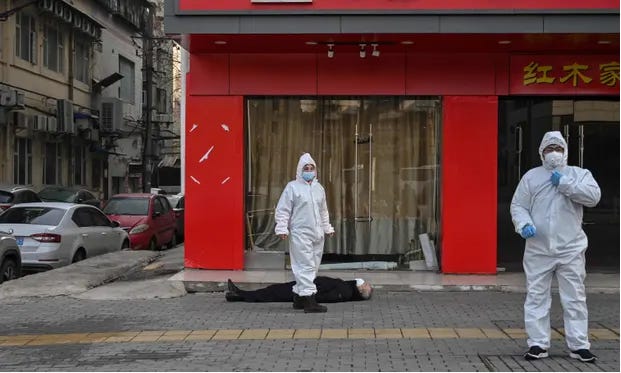
And this:
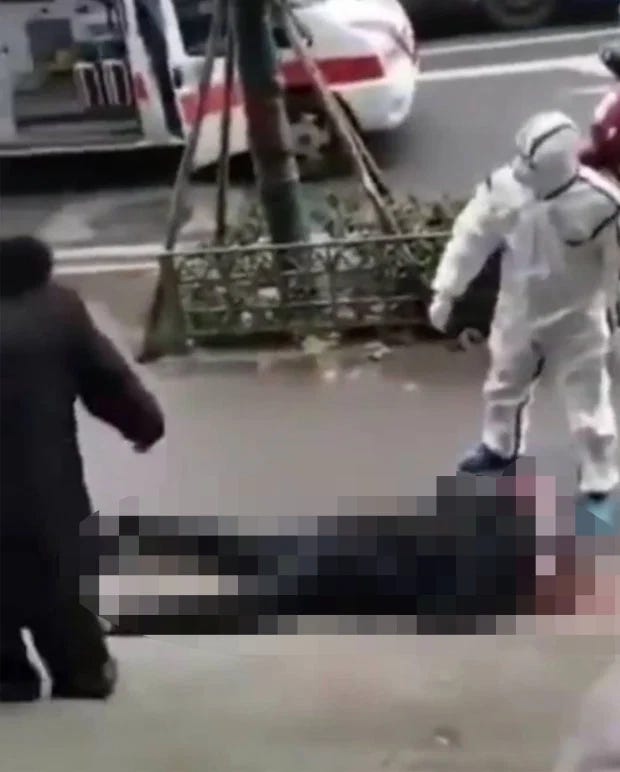
These images were shown around the world in publications such as The Guardian, The Independent, France24, The Sun, and The Mirror. They happened to be published starting on January 30, 2020 which also happened to be the day that the WHO declared a global emergency. These photos of people lying dead in the streets being tended to by workers in hazmat gear clearly sent a message, and that message went something like this: Coronavirus is no joke. People are falling over dead where they stand. Be afraid!
Of course, no one wrote those exact words. They didn’t need to, they let the pictures do the talking. If you read the articles in which the photographs are featured, such as A man lies dead in the street: the image that captures the Wuhan coronavirus crisis by The Guardian, you’ll find that they say:
“Journalists from Agence France-Presse saw the body on Thursday morning, not long before a vehicle arrived carrying emergency workers. AFP could not determine how the man, who appeared to be aged in his 60s, had died.
But the reaction of the police and medical staff in hazmat suits, as well as some of the bystanders, highlighted the fear pervading the city.
AFP contacted police and local health officials afterwards but could not get details on his case.
A woman standing near the man said she believed he had died from the virus.
“It’s terrible,” she said. “These days many people have died.”
There is no way to know what killed this old man, or even if he died right there on the street. But that didn’t stop the Guardian from claiming in the title of the article that the image “captures the coronavirus crisis.” It’s lying without lying. Let the pictures do the talking and the public can fill in the blanks in their minds. Maybe the editors meant that the crisis captured was that EMT’s now wear hazmat suits as a precaution, but that’s not going to be the takeaway of their audience. The reader is going to clearly think that the crisis captured on film is that this new virus which is headed our way can kill you on a dime. (Of course, there is a whole can of worms here about the Chinese Communist Party and whether or not they would actually let foreign reporters capture and publish image after image of dead people in the streets, or whether they would let Chinese nurses upload videos of people dying on hospital floors and the like if they didn’t want that exact thing to happen, but we’ll save that can for another day.)
We have all lived through the pandemic for over a year, and now the idea of people dying the streets seems pretty absurd – at least to those of us not duct taping ourselves into our homes. But clearly, since the beginning of the COVD-19 pandemic, the media has been fanning the flames of fear in the public with almost every move they’ve made, and in some cases have gone beyond quoting the most panicked experts or publishing images of unverified incidents under incendiary headlines, to outright using video and photography from totally unrelated places and people in order to sell their narratives.
In March of 2020 CBS was caught using footage from a crowded Italian hospital, and claiming that it was in New York City. And then, on April 26, the New York Post ran an article called COVID surge ‘swallowing’ people in India, footage shows people dead in the streets. If you visit the link now, you won’t see the original photo that they had under the header (or the original title), because they were forced to remove it when they were caught using a picture from a totally unrelated incident. You can see their chicanery in all its glory below:
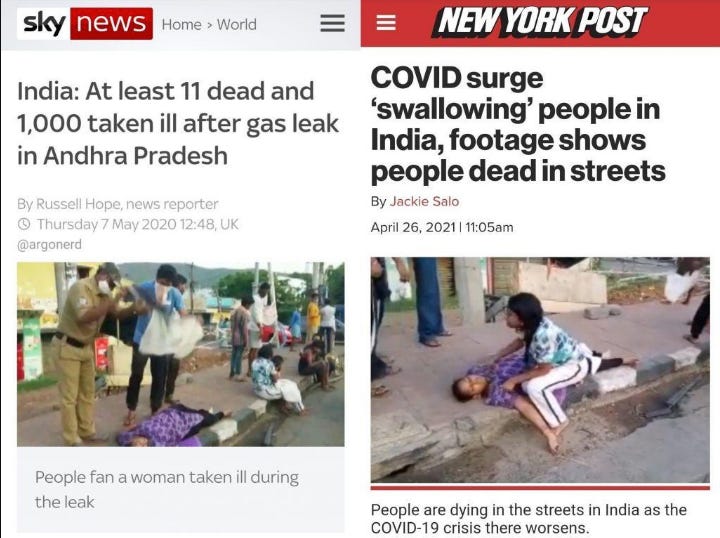
Yep, they used a photo of a woman who was alive, and gasping for breath after being caught in a gas leak in an article about people dropping dead from coronavirus in the streets. Does anyone actually believe these are simple mistakes made by editors at major news organizations? What makes all of this bad reporting so damaging is that in today’s media environment, it’s not like people read one or two newspapers regularly, and can on the daily check for corrections and retractions. These images and boldfaced headlines generate their intended perceptions, and then people mostly move on to the next tweet in their timeline, never to revisit old media again. The fear that is falsely generated is never unmade. There is never that “phew!” moment where the public can return to baseline calm. Instead they are hit with the next article, the next claim, the next terrifying fact that will turn out to be untrue (remember how multi-organ failure “Kawasaki syndrome” caused by Covid was going to start wiping out kids?)
The images put before use shape our perceptions. If this wasn’t true, you wouldn’t cry when E.T. asked Eliot to board his ship and no one would care if Fred Flintstone smoked cigarettes. On September 11th, when there were Palestinians in the west bank cheering the attack on the United States, that footage was played on major US news networks. Why? Of what relevance were these individuals thousands of miles away? If it bleeds, it leads baby, and nothing draws blood like the 101 Airborne, so how do you piss off a bunch of hot blooded Americans? Show them a bunch of brown foreigners celebrating an American tragedy.
The Covid playbook is nothing new. Unfortunately, skepticism of media seems to be mostly political, with individuals only applying skepticism to the networks and publications that promote their political rivals. But the reality is that the news networks and publications and their advertisers at Pharma have been all too happy to keep you on the edge of your seat waiting for you vaccine and chomping on all the anti-anxiety meds you can afford in the meantime. The only tragedy for them, is that the pandemic has to end eventually.
One Reply to “Fill in the Blank”
Comments are closed.